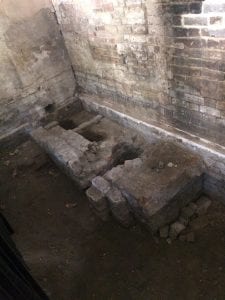Interpreting & Preserving Lives of the Enslaved in Antebellum Charleston

The back exterior of the three-story Aiken-Rhett House is directly adjacent to the coach house dependency. Photo by author.
One of the stops on the Southern Trip was the Aiken-Rhett House in Charleston, South Carolina. This historic house museum practices a unique approach to interpreting the past through an “as-found” approach. Essentially, this means that the house and dependencies remain preserved to the state they were in when the Historic Charleston Foundation acquired the property in 1995. At that time, it obtained the house and all of its surviving dependencies, including the slave quarters, which have remained relatively untouched since the 1850s.

One the left stands the dependency containing the coach house, and to the right is the dependency containing quarters for the enslaved individuals working at the antebellum house.
Walking into these quarters offered a glimpse into the day-to-day life of an enslaved individual living in urban antebellum Charleston. Though the exposed lath and chipping paint visible today creates a dreary picture compared to the brightly colored main house, it is possible to imagine the quarters as they once appeared to their inhabitants. The knowledge that the state that the structures are in today is how they were found in the 1990s ensures that the visitors to the site effectively feel the presence of the past residents. This approach differs to ones taken by other sites we visited during the southern trip, such as Drayton Hall or Poplar Forest, in that the presence of the past residents of the house and slave quarters could still be felt, not just read and/or interpreted through architectural hierarchies of space and design.

The peeling whitewashed walls reveal lath and brick surfaces in a space used for cooking at the Aiken-Rhett enslaved quarters.
However, the quarters alone are not enough to tell the story of the enslaved individuals working at this house. In 2015 an archaeological excavation was conducted at the laundry room in order to uncover more about these individuals’ lives and their material world. I thought it was wonderful that a historic house museum utilized archaeology and archaeological artifacts to add another layer to their “as-found” approach. In situ is a term utilized to refer to artifacts that remain in their original spots of deposition; they haven’t been moved since they made their way into the ground. The archaeological excavations in the laundry uncovered foundations of brick structures that have been left uncovered so that visitors can see what was once at the laundry site in situ, or in its original position. In this sense, the Aiken-Rhett House actively merges the past and the present, presenting visitors with a history of the laundry space and how it has been used and modified over centuries of use.
A small archaeological exhibit in the laundry showcases just some of the more than 10,000 artifacts found during the dig. These artifacts were taken from their in situ positions and put in display cases in order to highlight the material world of the people inhabiting and using the laundry space for visitors. Some of the finds on display include tobacco pipe bowls and stems, marbles, toothbrushes, pencil lead, glass bottles, and an entire exhibit case full of buttons! All material objects that are still used and understood by us today in the 21st century, making the material past more relatable to the present.

Some everyday objects such as pieces of pottery, marbles, and toothbrushes are displayed in an exhibition case at the laundry site, encouraging visitors to see which items are familiar to them & help them make connections between the past and present material worlds.
However, something as seemingly common as a pencil can have a more complex story to tell depending on the context in which it was found. The Aiken-Rhett House does not shy away from discussing issues of race in their archaeological exhibit cases. For example, the pencils found on-site are being interpreted as possible signs of the illegal education of enslaved individuals working at the Aiken-Rhett house in the antebellum period, or a sign of formerly enslaved individuals learning to read and write after the Civil War. This is just one of many stories that can be told based on the material culture unearthed using archaeology at the Aiken-Rhett House. Overall, my experiences at the Aiken-Rhett House were extremely positive and enlightening. Their “as-found” approach implemented through interpretation, architecture, and archaeology helped me to see the present in the past, and the past in the present.
By Alexandra Rosenberg, WPAMC Class of 2019


Leave a Reply